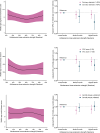Physical fitness in male adolescents and atherosclerosis in middle age: a population-based cohort study
- PMID: 38355280
- PMCID: PMC11041617
- DOI: 10.1136/bjsports-2023-107663
Physical fitness in male adolescents and atherosclerosis in middle age: a population-based cohort study
Abstract
Objectives: To examine the associations between physical fitness in male adolescents and coronary and carotid atherosclerosis in middle age.
Methods: This population-based cohort study linked physical fitness data from the Swedish Military Conscription Register during adolescence to atherosclerosis data from the Swedish CArdioPulmonary bioImage Study in middle age. Cardiorespiratory fitness was assessed using a maximal cycle-ergometer test, and knee extension muscular strength was evaluated through an isometric dynamometer. Coronary atherosclerosis was evaluated via Coronary Computed Tomography Angiography (CCTA) stenosis and Coronary Artery Calcium (CAC) scores, while carotid plaques were evaluated by ultrasound. The associations were analysed using multinomial logistic regression, adjusted (marginal) prevalences and restricted cubic splines.
Results: The analysis included 8986 male adolescents (mean age 18.3 years) with a mean follow-up of 38.2 years. Physical fitness showed a reversed J-shaped association with CCTA stenosis and CAC, but no consistent association was observed for carotid plaques. After adjustments, compared with adolescents in the lowest tertile of cardiorespiratory fitness and muscular strength, those in the highest tertile had 22% (OR 0.78; 95% CI 0.61 to 0.99) and 26% (OR 0.74; 95% CI 0.58 to 0.93) lower ORs for severe (≥50%) coronary stenosis, respectively. The highest physical fitness group (high cardiorespiratory fitness and muscular strength) had 33% (OR 0.67; 95% CI 0.52 to 0.87) lower OR for severe coronary stenosis compared with those with the lowest physical fitness.
Conclusion: This study supports that a combination of high cardiorespiratory fitness and high muscular strength in adolescence is associated with lower coronary atherosclerosis, particularly severe coronary stenosis, almost 40 years later.
Keywords: Cardiovascular Diseases.
© Author(s) (or their employer(s)) 2024. Re-use permitted under CC BY-NC. No commercial re-use. See rights and permissions. Published by BMJ.
Conflict of interest statement
Competing interests: EH reports payments to institution from Pfizer and Amgen, small personal fees from Amgen, NovoNordisk, Bayer and AstraZeneca, small personal fee from Amarin AB for participation on advisory board. He is the co-chair of the Swedish secondary prevention registry and the national coordinator for the trials DalCore DAL301 DalGne, Regeneron R1500-CL-1643 and Aegis II/Perfuse. The remaining authors report no competing interests.
Figures



Similar articles
-
Associations of psychological factors with atherosclerosis and cardiovascular health in middle-age: the population-based Swedish CArdioPulmonary bioImage study (SCAPIS).BMC Public Health. 2024 May 30;24(1):1455. doi: 10.1186/s12889-024-18924-w. BMC Public Health. 2024. PMID: 38816713 Free PMC article.
-
Cardiorespiratory fitness, muscular strength, and obesity in adolescence and later chronic disability due to cardiovascular disease: a cohort study of 1 million men.Eur Heart J. 2020 Apr 14;41(15):1503-1510. doi: 10.1093/eurheartj/ehz774. Eur Heart J. 2020. PMID: 31710669 Free PMC article.
-
Prevalence of Subclinical Coronary Artery Atherosclerosis in the General Population.Circulation. 2021 Sep 21;144(12):916-929. doi: 10.1161/CIRCULATIONAHA.121.055340. Epub 2021 Sep 20. Circulation. 2021. PMID: 34543072 Free PMC article.
-
Muscular fitness and cardiorespiratory fitness are associated with health-related quality of life: Results from labmed physical activity study.J Exerc Sci Fit. 2019 Jan 20;17(2):55-61. doi: 10.1016/j.jesf.2019.01.002. Epub 2019 Jan 8. J Exerc Sci Fit. 2019. PMID: 30740134 Free PMC article. Review.
-
An Update on Secular Trends in Physical Fitness of Children and Adolescents from 1972 to 2015: A Systematic Review.Sports Med. 2021 Feb;51(2):303-320. doi: 10.1007/s40279-020-01373-x. Sports Med. 2021. PMID: 33159655 Free PMC article.
Cited by
-
Cardiorespiratory fitness in adolescence and risk of type 2 diabetes in late adulthood in one million Swedish men: nationwide sibling controlled cohort study.BMJ Med. 2025 Aug 7;4(1):e001313. doi: 10.1136/bmjmed-2024-001313. eCollection 2025. BMJ Med. 2025. PMID: 40791770 Free PMC article.
-
Health, Performance Ratings and Approachability of 50-60-Year-Old Sedentary Adults (ActIv-Study): Key Insights for Health Economy and Exercise Promotion.Int J Environ Res Public Health. 2024 Jul 24;21(8):969. doi: 10.3390/ijerph21080969. Int J Environ Res Public Health. 2024. PMID: 39200580 Free PMC article.
References
-
- Roth GA, Abate D, Abate KH, et al. . Global, regional, and national age-sex-specific mortality for 282 causes of death in 195 countries and territories, 1980–2017: a systematic analysis for the global burden of disease study 2017. The Lancet 2018;392:1736–88. 10.1016/S0140-6736(18)32203-7 - DOI - PMC - PubMed
